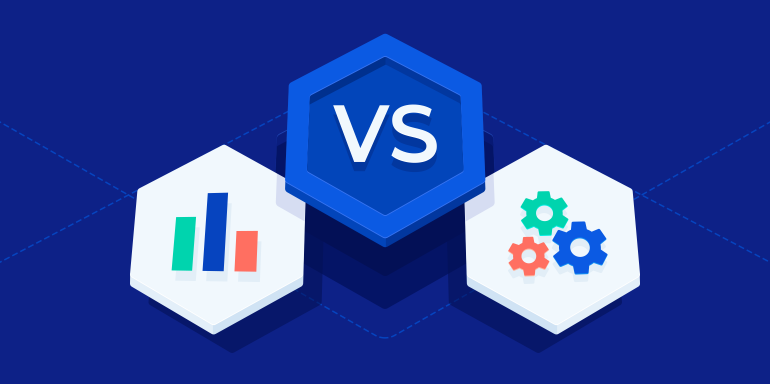The end goal of all advertising campaigns is business growth.
That Facebook campaign you’re running for brand awareness will ultimately generate more business growth, the same goes for the remarketing display ads you’re targeting to visitors who’ve abandoned their shopping carts, and the search ads for that free trial offer.
Advertisers want growth — and you can use two processes to get there.
Both optimization and automation help advertisers achieve business growth, but what differentiates them is how to use each process in campaigns to achieve that growth.
Today’s post highlights the differences between optimization and automation. We will begin by defining both processes as they relate to campaign creation and how your audiences see them. To close, we demonstrate why automation is superior to optimization when it comes to getting advertising conversions.
What is optimization?
Optimization is a widely known term in the advertising world. It allows digital advertisers to improve their campaigns to the point that they’re as near-perfect as they can get. Optimization is a circular process of data collection, testing, and making improvements to campaigns based on those results.
And it’s accomplished at both the pre- and post-click stage.
Optimization at the pre-click stage
At the pre-click stage, advertising platforms such as Facebook Ads and Google Ads provide you with options to create better ads and run your campaigns more effectively. Among the many tactics available on each platform:
- Facebook Ads offers advertisers the Optimizing for Ad delivery, which aims to get you desired results as efficiently as possible. For example, optimizing Facebook Ads for link clicks, will show your ads to an audience who are most likely to click the ads.
In addition to ad delivery, Facebook also optimizes the campaign set-up process by pre-selecting the best options for you. For instance, the platform pre-selects the ad placement it thinks is best for your campaign, your budget, and helps you narrow down the target audience.
- Google Ads: Advertisers can create ad extensions to optimize their ads for audiences, and can also use Google’s Keyword Planner tool to estimate how many clicks a keyword is likely to generate each day.
By optimizing the ad creation process, the correct audience sees a relevant ad at the right time. An optimized ad has a headline that explains the offer, a relevant and appealing image (for display ads), copy that gives the user information about the offer, and a CTA button that contrasts with the page and tells the visitor the next step.
When I Work has an optimized Google search ad:
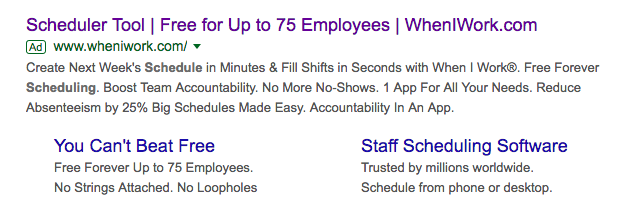
For display ads, both Atlassian and Thrive Market designed optimized ads:
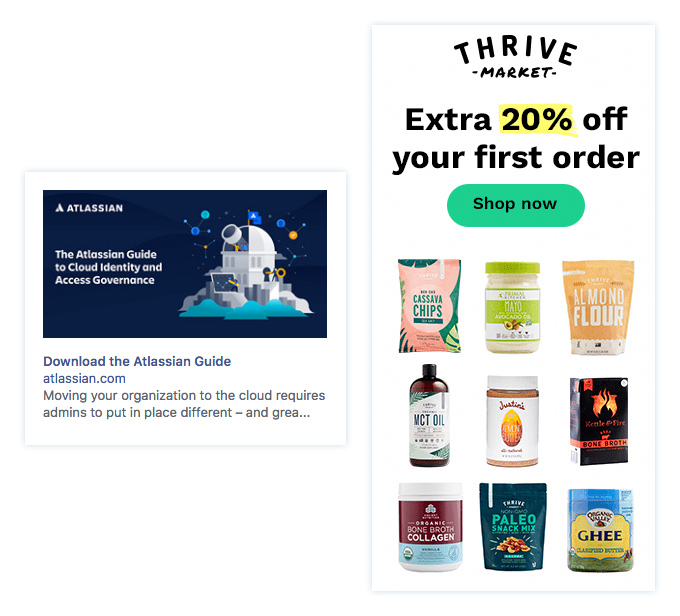
Optimization at the post-click stage
Post-click optimization is the process of improving the components of your post-click landing page i.e. the post-click landing page, thank you page, and thank you email to the point that all of them are as near perfect as they can be.
The two primary ways to optimize post-click landing pages are:
- Heat maps provide you with a visual guide of visitor behavior, allowing you to see the post-click page through the visitor’s eyes.
- A/B testing involves testing your original page design, referred to as the control page (A) with alternate variation (B). Tests typically involve directing equal amounts of traffic to both pages and seeing which variation outperforms the other.
Heatmaps collect data on post-click pages as well, which you can then run A/B tests to prove or disprove. You can collect customer data for A/B testing through Google Analytics, user recordings, and surveys.
Optimized post-click landing pages provide the best user experience which then translates into more advertising conversions.
All elements of an optimized post-click page from the headline down to the customer testimonials are relevant to the offer being promoted on the page.
Optimized post click pages are free of navigation links, include a persuasive headline, copy that explains the UVP, eye-catching and relevant media, a contrasting CTA button with personalized copy, and credibility-enhancing elements (trust seals, customer badges, testimonials).
Thrive Market has an optimized post-click page:
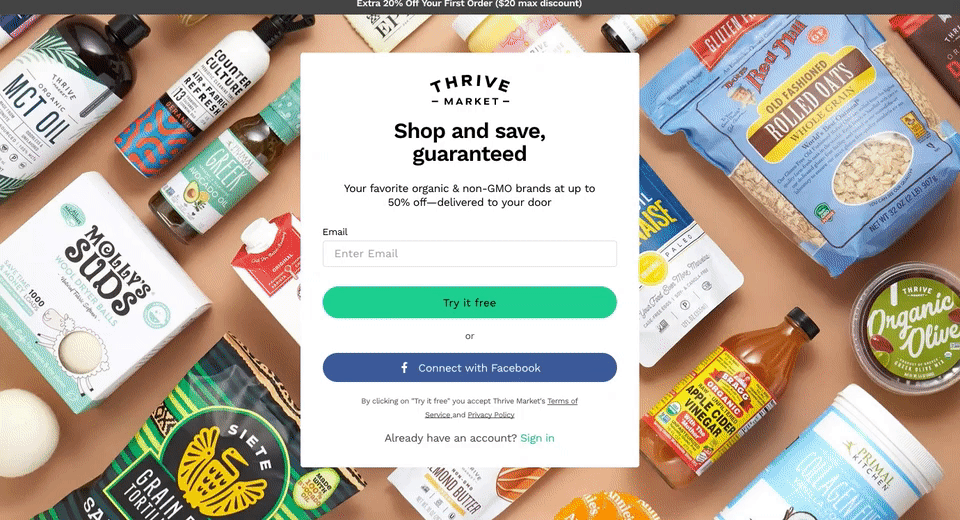
The When I Work post-click page is also optimized:
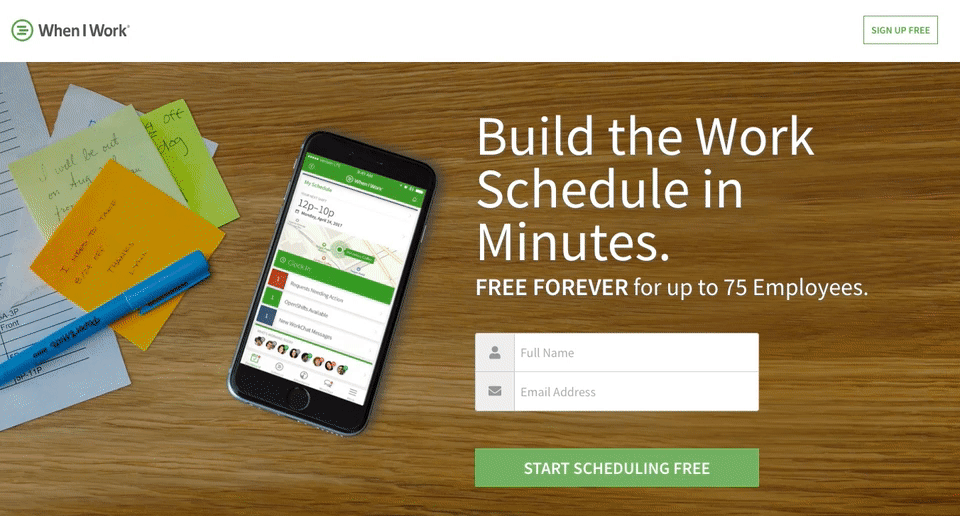
Optimization allows marketers to use capabilities offered by advertising networks and post-click platforms to manually create ads and post-click pages that offer audiences a relevant experience and make the advertising conversion more likely.
Aside from heat maps though, optimization is largely a manual process. For example, optimizing post-click landing pages requires developers to code each variation, which prevents marketers from moving at the speed of advertising.
What is automation?
Advertising automation encapsulates technologies that empower marketers to automate, and measure marketing activities, workflows, and strategies to attract customers faster and facilitate faster growth.
Advertising automation is no longer only related to email marketing. When automation is combined with intelligent user behavior it helps engage prospects through relevant content that successfully converts them and increases your advertising conversions.
Automation helps save both time and money for marketers:

Brands that use advertising automation software see:
- 451% increase in qualified leads
- 14.5% increase in sales productivity
- 12.2% reduction in marketing overhead
Advertising automation is slowly phasing out human error by reaching the phase of machine learning in terms of predictive machine intelligence.
While optimization is a manual process, i.e. the advertiser must select the appropriate options in the advertising platforms and select an A/B test schedule, assess heat map analysis, and make changes to post-click pages accordingly.
Advertising automation is, by nature, an automatic and immediate process, it brings together new and existing capabilities scattered across different categories into one category helping advertisers easily achieve business growth. For example, marketing automation brought together new capabilities, like automated journeys, and existing capabilities, like sending bulk emails, into a single category.
Advertising automation also includes omnichannel or multichannel experiences. Let’s look at automation at the pre-click and post-click stage.
Pre-click automation
Automation at the pre-click stage involves tasking the advertising platform to automatically select the options that are best for your campaigns. Pre-click automation is well-established because advertisers have multiple options to automate ad campaign creation, schedule, bid, and the delivery system of the ads.
- Facebook Ads: The platform recently launched Automated Ads, which provide advertisers with a custom advertising plan and then will create relevant ads to run on an ongoing basis.
- Google Ads: The platform recently launched automated Smart campaigns that help highlight the selling points of your business and attract customers. You can create a single campaign for your business, or run multiple campaigns to showcase different products or services. Smart campaigns offer automatic targeting (across all Google properties) and automated goals-based bidding.
In addition, Google Ads also offers conversion action sets, bid automation, automated targeting, and content automation with automated responsive search ads, responsive display ads, dynamic search ads, dynamic remarketing, and ad suggestions.
Post-Click Automation
Post-Click Automation (PCA) is the category of marketing technology that enables marketers to maximize advertising conversions by automating the post-click stage in the advertising funnel. This is accomplished by delivering 1:1 personalized experiences at scale. It is comprised of the four main pillars here:
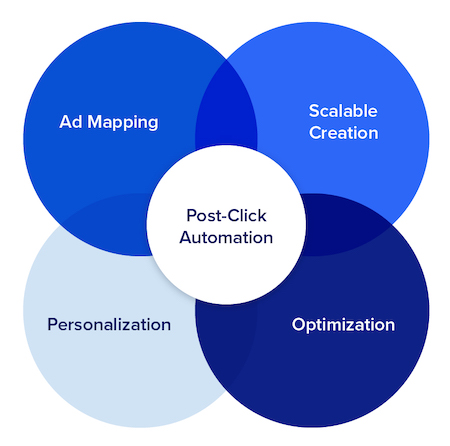
This new category of technology is an extension of Post-Click Optimization (PCO) since it involves creating optimized experiences personalized to each audience segment. It starts with visualizing the advertising funnel and connecting it with the ad network to create message matched post-ad click pages. That is accomplished with features like Instablocks™.
Advertising automation simplifies the process of creating customer journeys and capturing new leads via omnichannel or multi-channel experiences. Omni-channel marketing aligns experiences across multiple platforms which may include any marketing channels such as your website, display ads, retargeting ads, post-click pages, etc.
Disney omnichannel experience example
Let’s take Disney’s omnichannel experience as an example of what advertising automation looks like.
A user looking to book a trip to Disney World begins their initial experience on Disney’s mobile-responsive website. Once they’ve booked a trip, they can use the My Disney Experience tool to plan their entire trip, from where they want to eat to securing their Fast Pass.
Once they are In the park, they can use their mobile app to locate the attractions they want to see, as well as view the estimated wait time for each attraction:

Disney takes it’s automation one step further with the release of its Magic Band program. This tool acts as a hotel room key, a photo storage device for any pictures taken of you with Disney characters, and a food ordering tool. Plus, it even has Fast Pass integration to keep your vacation moving.
With advertising automation, the user gets a seamless, optimized experience, while the advertiser saves time and money because of the automated process.
Automation is immediate, optimization is manual
Both advertising automation and optimization deliver persuasive and relevant experiences to audiences that convince them to act — leading to more conversions and overall growth. However, optimization is primarily a manual process, which takes more time resources, whereas automation is an immediate and more efficient process.
Once you find your chosen automation platform, forget about hiring resources to do the work you don’t know how to do because the platform handles everything automatically.
There are endless possibilities with advertising automation and Post-Click Automation should be a high priority for your team. See how Instapage automates advertising conversions by getting a customized demo here.

See the Instapage Enterprise Plan in Action.
Demo includes AdMap™, Personalization, AMP,
Global Blocks, heatmaps & more.
